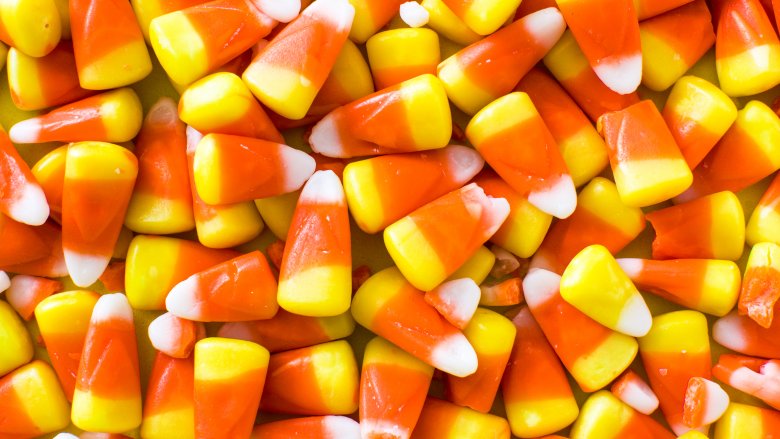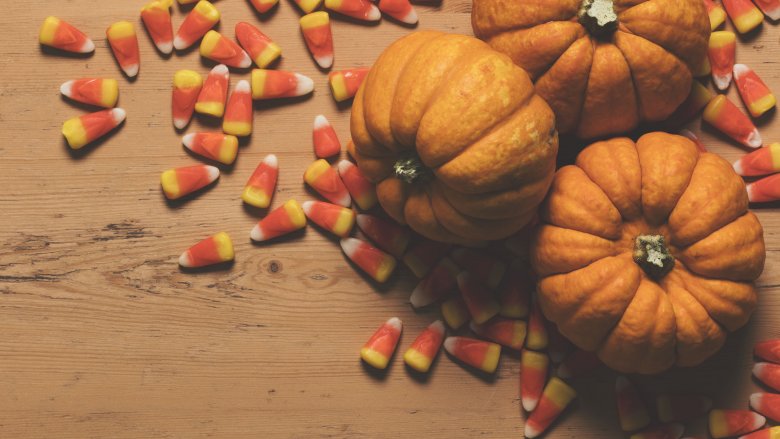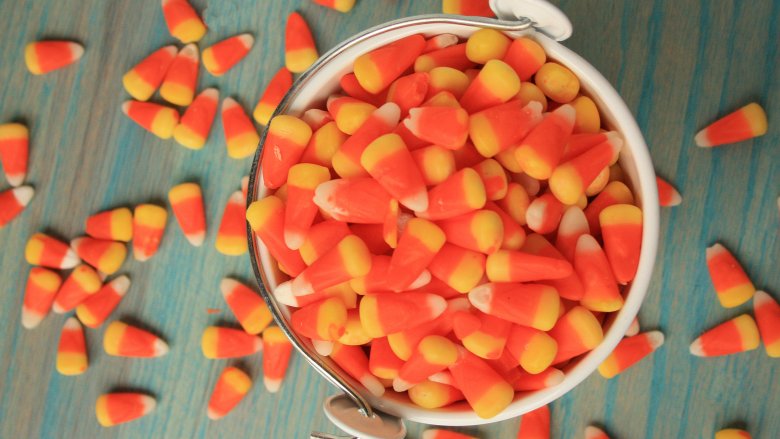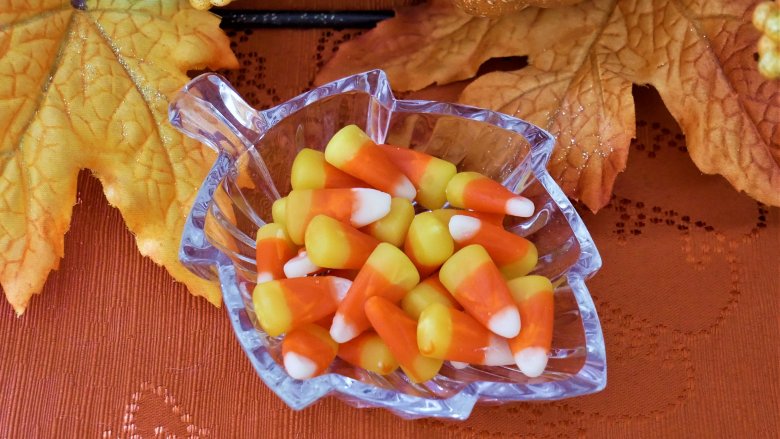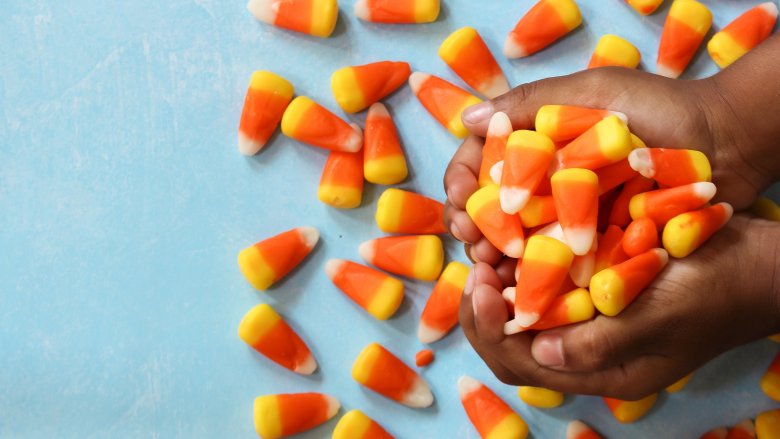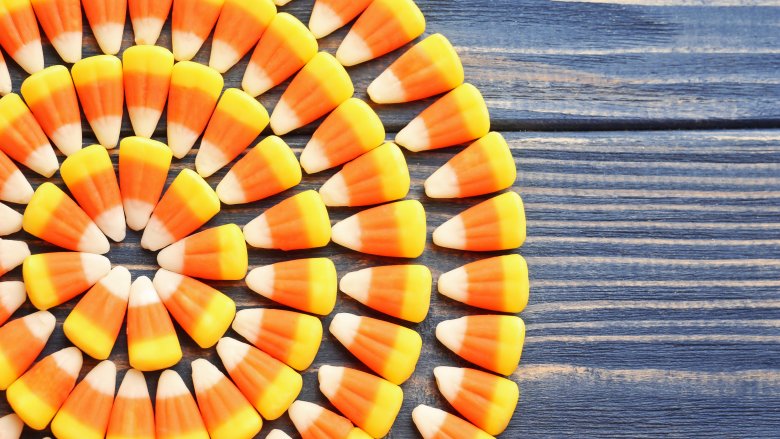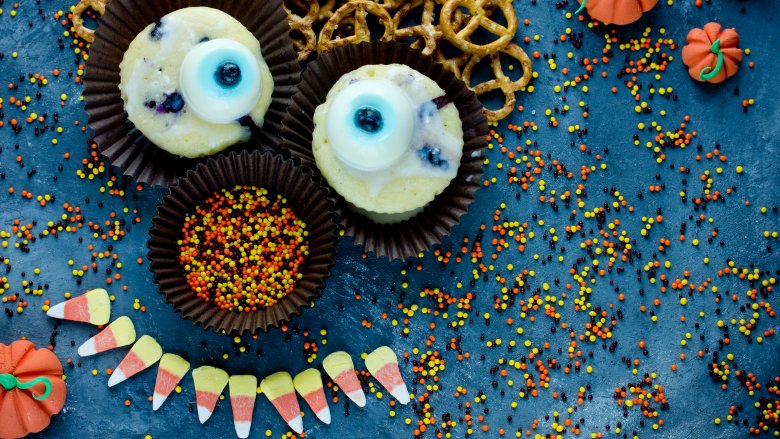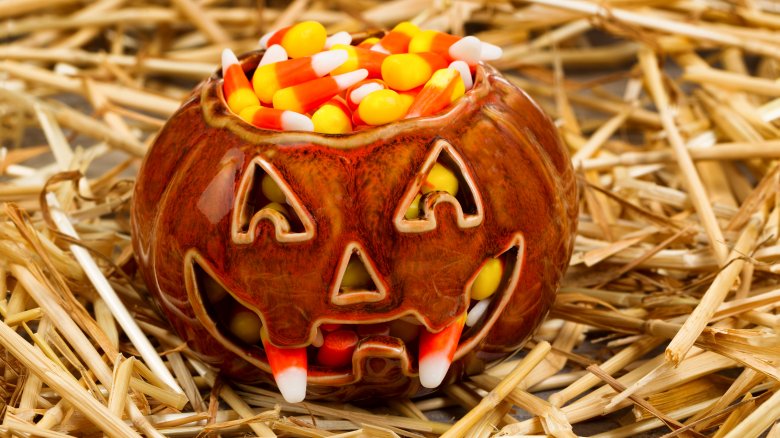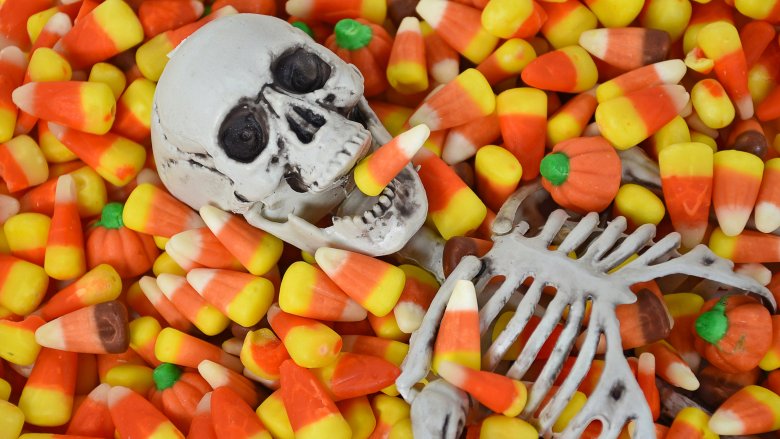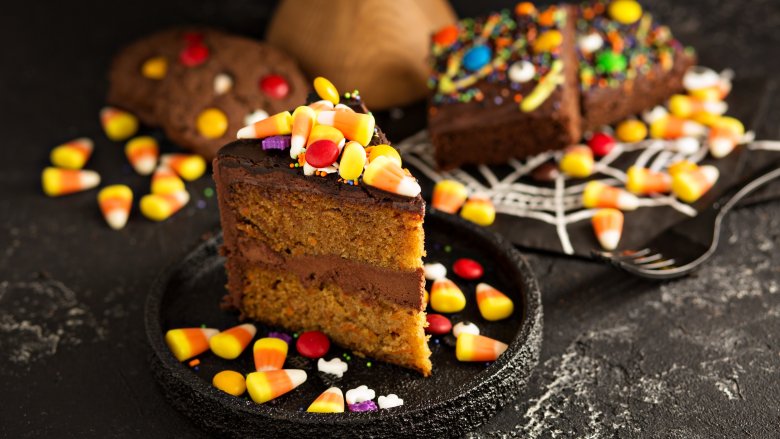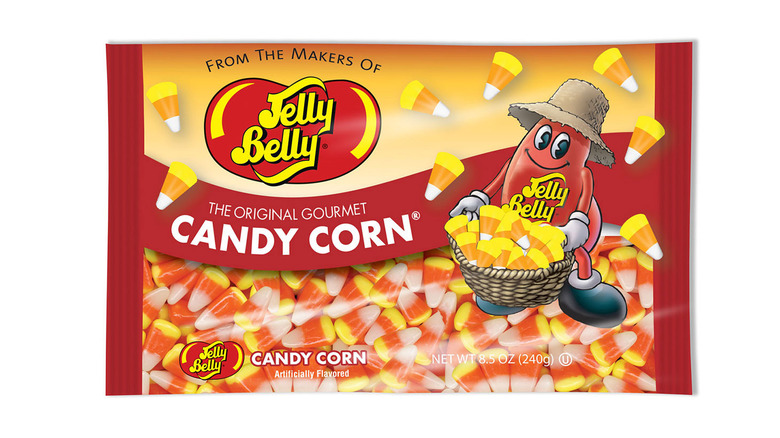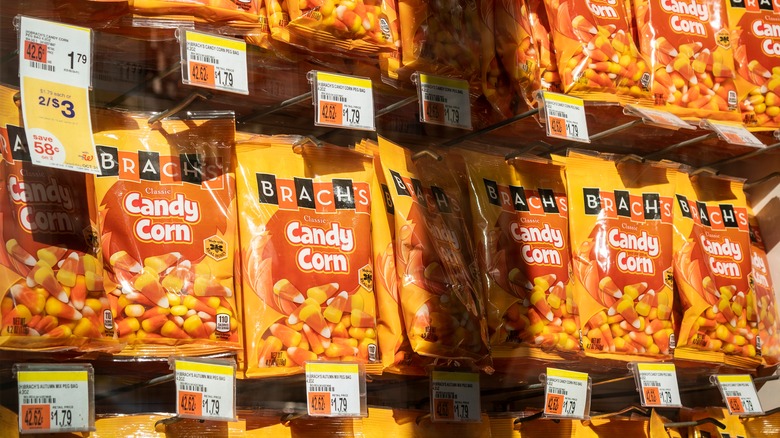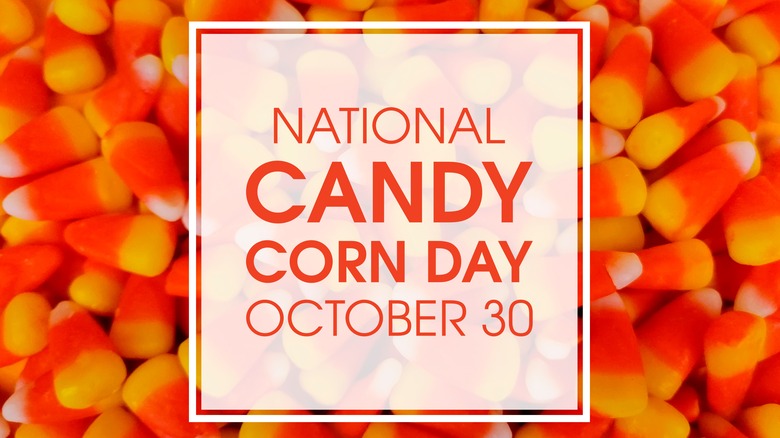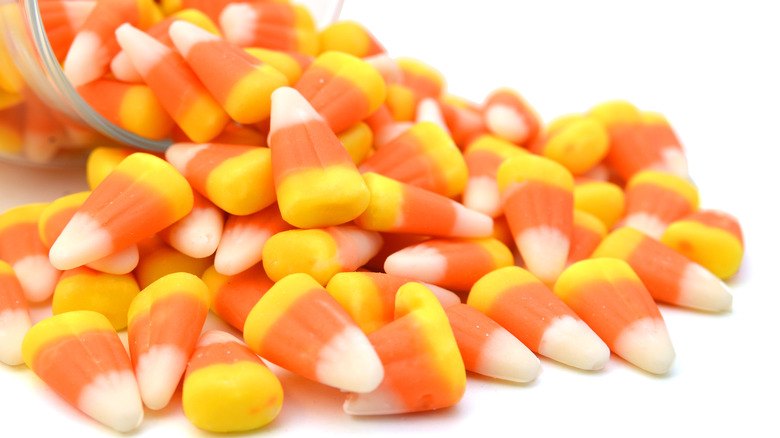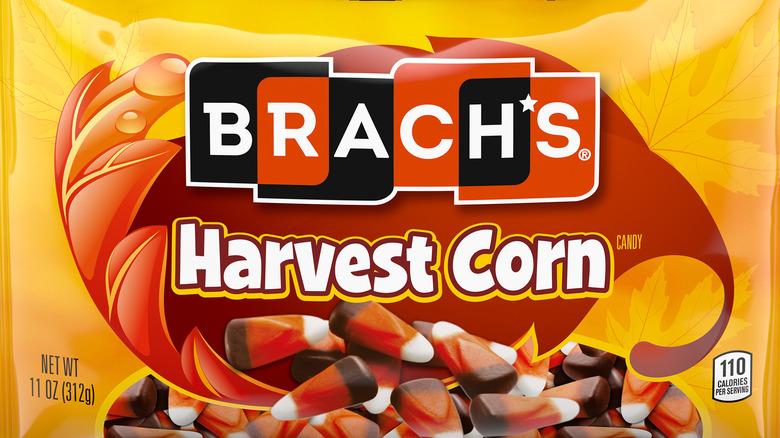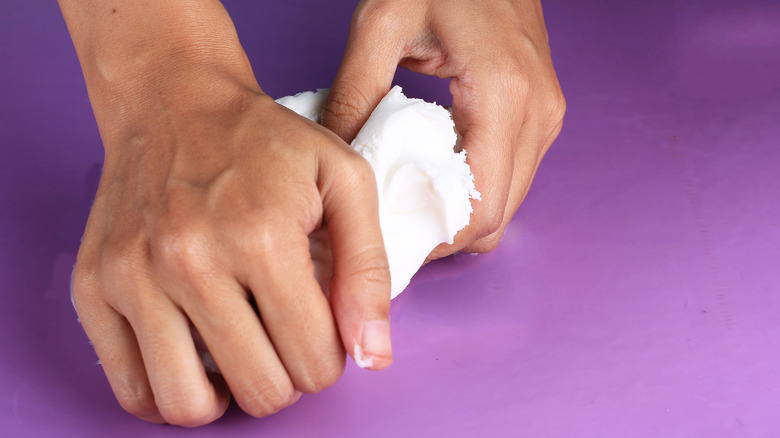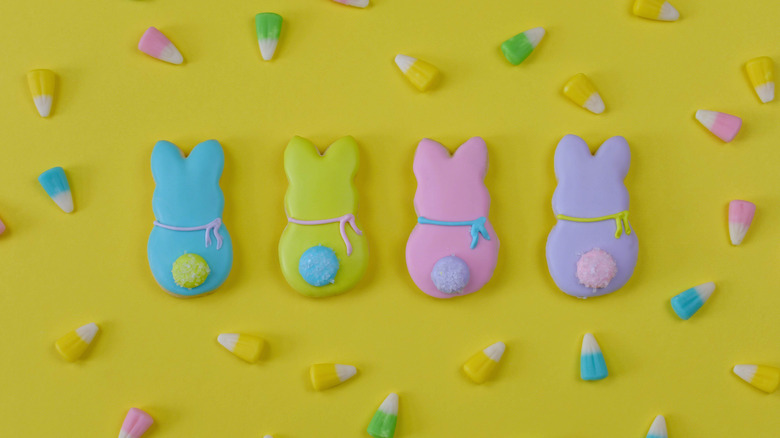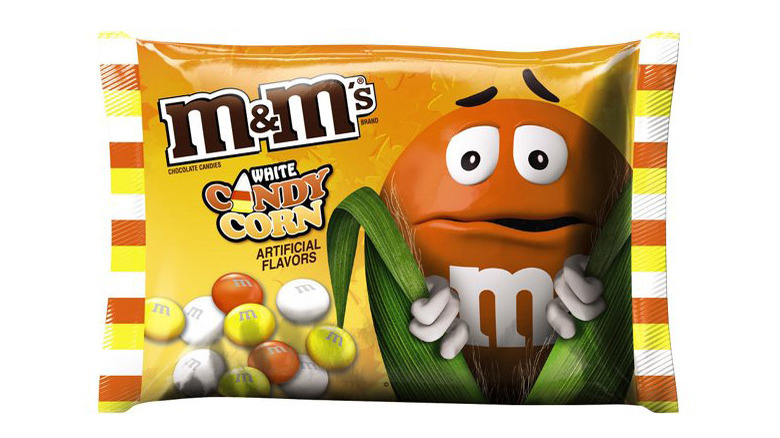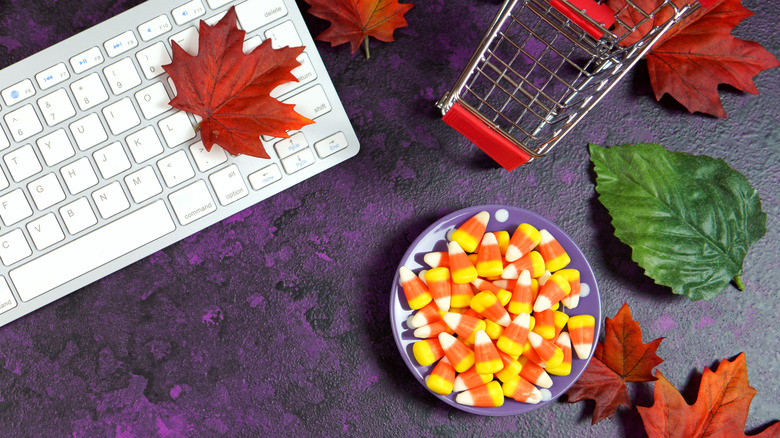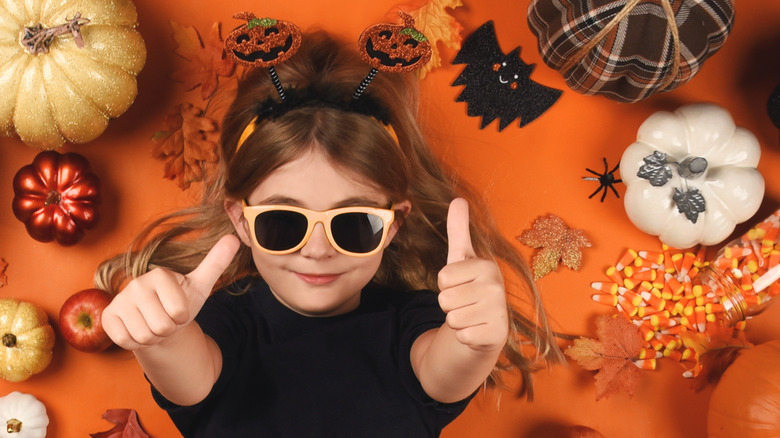The Strange History Of Candy Corn
Everyone has their likes and their dislikes, but there are a few foods that are polarizing to the extreme. Cilantro is one of them, a leafy green that people either love or want to see condemned to the deepest circle of Dante's "Inferno." Candy corn is pretty much the sweet version of that savory love-or-hate food.
Some people wait for it to hit the shelves, and the high point of the autumn season is putting bowls of it out for some serious picking. Other people? Not so much. It's the Halloween candy that's bought out of some sort of feeling of cultural commitment. It sits, and when the season is over, it gets thrown away when no one's looking. You know all that, but you might not realize that candy corn has a long and very weird history you can appreciate whether you like it or not.
It started as Chicken Feed
National Geographic says that no one is completely 100% sure just who invented this overly sweet treat, but it's been around for a long time. The accepted story is that the Wunderle Candy Company and a candymaker named George Renninger are to thank (or blame) for first making candy corn. In 1898, the Goelitz Confectionery Company picked up his creation and ran with it.
Corn-inspired candy is weird, but it hearkens back to what candy corn was originally meant to represent. It was first marketed as "Chicken Feed," and it was a candy that drew its inspiration from an industry that helped build America: agriculture. It was meant to appeal to the farmers, the ranchers, and their families, and it absolutely did.
There's a bit of irony here, too. At the time candy corn was getting popular, corn wasn't a dietary staple ... at least, not for people. The Atlantic notes that at the turn of the century, corn was mostly used for animal feed. It wasn't until World War I that eating corn was a necessity, and prior to that, corn-shaped candy would have been a hilarious novelty.
It was pretty groundbreaking
Candy corn was a big deal, but not because it was something completely new. Not entirely.
During the late 19th century, there were a ton of confectioners making that kind of candy. They were called butter creams, and The Atlantic says they were a pretty standard option when it came to candy. Most were even molded into shapes also inspired by farming, agriculture, and the natural world. Anyone heading into a 19th-century candy store could expect to find butter creams shaped like everything from clover to turnips, so what made candy corn extra impressive?
It was those three layered colors that people had never seen before, and it was eye-catching and novel enough to make it a major hit. It's a good thing, too. Producing it was a complicated labor of love, as each of those colors needed to be layered one at a time, all by hand. It was totally worth it.
It wasn't always for autumn
Today, we think of candy corn — and its vegetable and cornstalk cousin candies — as being heralds of the autumn season. It's a Halloween staple, it reminds us of the end of the growing season, the harvest, and the coming winter months. It wasn't always like that, though.
Take one 1957 issue of LIFE magazine that features an epic, sprawling spread advertising "Brach's Summertime Candies." The candy featured was "Created for your Summertime Enjoyment," according to the headline, and it included all kinds of mints, coconut bonbons, circus peanuts, toffees, jelly beans, and candy corn.
The Atlantic says it was about that time that a post-war world started advertising candy as being perfect for holidays like Easter and Halloween, and candy corn was one of the staple penny candies sold all year long. Candy corn started out as being associated with all the holidays, and it eventually became so popular as an autumn candy that manufacturers needed to switch up the colors to entice people to buy it at other times of the year.
Why you love it or hate it
There was a time when candy corn wasn't nearly as polarizing as it is now, so what's going on here?
The Supermarket Guru Phil Lempert had a theory he shared with Adweek (via Vox). He suspects it's just one of many generational differences and says that for baby boomers, candy corn was a delicious, once-a-year treat that was a huge deal. They love it because it brings memories of childhood, and it's a fondness that has little or nothing to do with the actual taste. Anyone coming of age in the '50s and '60s remembers it that way, the same way later generations think of more modern candies like Starburst and Skittles.
Is it all in what you loved as a kid? Or is there more to it? If it's all about fond memories over taste, is there going to come a point when it's just no longer relevant?
The right way to eat it
Whether or not it's good is only one of the epic disagreements that have happened over candy corn — there's also a huge argument over just what the right way to eat it is. The National Confectioners Association actually surveyed candy corn lovers to find out just how they eat it, and it's pretty surprising.
They found that while 51% of the people surveyed ate the whole thing at once, the rest ate it layer by layer. According to their survey, 33% of people nibble the small white end first. Only 16% of people start with the wide yellow layer. Given that it was the layers of different colors that helped make candy corn popular more than 100 years ago, it's pretty cool to know that even with all the technological advancements we've seen over the past decades, the candy corn colors are still as impressive to us as they were to our ancestors.
Wait, how many people like it?
So, we've mentioned that some people love candy corn and some people absolutely hate it. Comedian Lewis Black famously said, "The worst thing about Halloween is, of course, candy corn. All the candy corn that was ever made was made in 1911."
Harsh words, but how many people agree with him? Fewer than you might think.
When the National Confectioners Association surveyed Americans to find out what their favorite type of Halloween candy is, candy corn came in third. Chocolate was a clear winner with 60% of people voting for this candy staple.
The Candy Store decided to look at it another way and took 10 years of candy sales data (from 2007 to 2016) and compiled a list of favorite candies by state. It was more varied than you might expect, but a whopping six states had candy corn as their top candy: Alabama, Idaho, Michigan, New Mexico, Rhode Island, and South Carolina. Shocking, right?
It lasts longer than a Twinkie
Lewis Black may have joked that all candy corn was made in 1911, but there's a bit of fascinating trivia here. While Twinkies might have a reputation as the longest-lasting treat on the shelves, that's not true. When Twinkies were resurrected in 2013, they had a new, longer shelf life than they'd had before: 45 days, says NPR.
But candy corn can last a lot longer, and according to the National Confectioners Association, even if it's been opened it can last six months if it's stored properly. (That's in an airtight container, or in the fridge if you're in a hot, humid area, says Still Tasty). Unopened packages will last about nine months, and if you put that package in the freezer you can make it last up to a year. That's a lot longer than a Twinkie, so it turns out we should be talking about the suspicious longevity of candy corn, not Twinkies!
The candy corn scandal of the 1950s
You've heard the stories of how unsuspecting kids have found razor blades and poison in their Halloween candy, and while there have only been a few instances of adults handing out dangerous candy, poison expert Deborah Blum says (via Wired), candy corn was actually involved in a potentially deadly food scare.
In 1950, kids all across the country suddenly fell ill after Halloween. They developed some major gastrointestinal distress and broke out in welts and rashes. The FDA got involved and found it wasn't anything that had been added to the candy that made kids sick, it was one of the staple ingredients that had been in candy forever.
It was Orange Dye No. 1, and it was only when a ton of kids ate a ton of candy containing it that people started connecting the dots. It was used in all kinds of food from hot dogs to candy, and it was used to give candy corn and candy pumpkins their orange color. It had been approved in 1906, and it wasn't until the '50s that we realized the coal-tar sourced dye was poisonous. It was outlawed, dyes were changed, and we're still suspicious about funky-colored foods.
People have done insane things to it
Candy corn is so iconic, gone are the days when it was acceptable to just put a bowl out on the table for your party guests. These days, people have done all kinds of things to that unassuming bag of candy corn, and some we understand. They're great for adding to Rice Krispie treats for a fun autumnal twist, and you can do the same thing with chocolate chip cookies and chocolate bark. They're all great ways to cut some of that cloying sweetness that turns a lot of people away ... but some things we understand less.
Enterprising internet chefs have found that you can deep-fry candy corn, and it's surprisingly easy. Just wrap them with crescent roll dough and fry them up, and it's equal parts amazing and weird. It doesn't hold a candle to the weirdness of one Twitter user's candy corn-topped pizza creation. That bit of culinary trolling went massively viral in 2017, drawing rage (and the occasional bit of envy) from candy corn lovers and haters alike. Just goes to show that things can always get worse.
Jelly Belly has been making candy corn for over a century
Brach's has cornered the candy corn market, selling 85% of the candy corn consumed in the U.S. You would think it inherited the ancient recipe from a benevolent but eccentric candy corn wizard living on a remote mountain top. Obviously, that's not true. There's no such thing as a benevolent but eccentric candy corn wizard, and also, the Goelitz Confectionery Company has been making candy corn for longer than Brach's ... technically. It is no longer called the Goelitz Confectionery Company. In fact, it has a much more familiar name: Today it's called the Jelly Belly Candy Company, and besides making tiny jelly beans that no one can afford, it also (still) makes candy corn.
Other companies might sell considerably more candy corn than Jelly Belly, but Jelly Belly is quick to point out that it's been making candy corn continuously since the late 1800s, longer than any other candy maker in America (even Brach's).
Jelly Belly doesn't have a lot of especially creative versions of candy corn (it's too busy dreaming up weird Jelly Belly flavors like buttered popcorn and barf), but you can buy Jelly Belly brand giant candy corn in three mixed flavors.
There are 13 ingredients in candy corn
It is unnaturally orange and yellow and vaguely food-like, which is enough to make you imagine the novel-length list of terrifying ingredients candy corn probably contains. Shockingly, though, candy corn — as long as you categorize all the dyes under one heading — has a mere 13 ingredients. At least, Brach's candy corn does (ingredients vary by manufacturer).
Happily, most of those ingredients are pretty not-scary, like sugar, corn syrup, confectioner's glaze, salt, honey, and sesame oil. There's also hydrogenated palm kernel oil, gelatin, dextrose, and soy lecithin, which are slightly more ominous but not exactly poisonous or anything. Hydrogenated palm kernel oil is not-so-healthy palm oil that's been converted to a solid, gelatin is made from the connective tissue and bones of animals, dextrose is a simple sugar, and soy lecithin is an emulsifier derived from soybeans. The presence of gelatin means candy corn isn't vegetarian or vegan. There's also the vague "artificial flavor" and a rainbow of different colorings (Yellow 6, Yellow 5, Red 3, Blue 1, and Red 40).
Jelly Belly's candy corn has some vaguely familiar ingredients, too, plus carnauba wax (which comes from the carnauba palm tree) and beeswax, which makes it also not vegan, though it doesn't have gelatin.
Of course, just because there's nothing overtly toxic in candy corn doesn't mean there's anything healthy in it, either. But in the candymakers' defense, no one ever tried to claim that candy corn was good for you.
There's a National Candy Corn Day
Everyone needs a reason to throw a weird party, so you might as well have a party on National Candy Corn Day, which falls on the day before Halloween.
History does not seem to remember who made October 30 National Candy Corn Day. Still, the day is usually marked by at least a few people on the various social media platforms, like this Twitter user who suggested that National Candy Corn Day could be used to celebrate other vaguely corn-shaped things, like the weirdly corncob-like Marina City towers in Chicago.
Another Twitter user pointed out the strange irony that National Candy Corn Day falls on the same date as Sugar Addiction Awareness Day, in case you'd like to do some introspection while scarfing down a bag of candy corn. Still others celebrated National Candy Corn Day 2021 by posting photos of very, very unfortunate cats dressed as candy corn or memes of Jack-O-lanterns pooping candy corn, thus proving that National Candy Corn Day is indeed one of the world's most versatile holidays.
How much candy corn is sold each year?
Despite everyone you know saying that candy corn is the grossest thing ever, in 2004 Brach's said in a press release that it expected to sell 2 billion kernels of candy corn that year, which is only slightly deceptive since it's not like you actually have to buy the stuff by the kernel or anything. At the time, that was enough candy corn for everyone in the US to have 10 pieces, as if everyone in the US would actually share their candy corn. In case you're more of a weights and measures kind of person, 2 billion pieces of candy corn is equal to about 20 million pounds. Most of the candy corn Brach's sells (about 75% of it) is gobbled up by consumers during the Halloween season.
Times change, though, and today people are aware that candy corn is really not that great for you and should only be an occasional treat. Just kidding: In 2019 Brachs' VP of Marketing told Fox Business that it now sells 7 billion pieces of candy corn a year (worth about $73 million), which means it took only a decade and a half to more than triple its candy corn sales. And since Brach's has only 85% of the candy corn market, you can extrapolate from there how much additional candy corn is sold by other manufacturers if you're good at math.
Candy corn vs Harvest Corn
Because candy corn needed to be grosser, Brach's also has a version known as Harvest Corn, which is basically the same thing as candy corn only with chocolate. Not like actual, creamy milk chocolate or anything (if you're picturing something like a Cadbury cream-filled corn cob, you're going to be disappointed), but weird brown pseudo-chocolate at the top of each piece of candy corn where the yellow part is supposed to go. Evidently, some people actually think candy corn flavor goes with chocolate, but the weird brown part on a piece of Harvest Corn may or may not taste anything like chocolate to you depending on how low your standards are.
You're probably wondering what's actually in Harvest Corn that makes it different from standard candy corn, and the answer is literally nothing. In fact, Harvest Corn has exactly the same ingredients as Brach's classic candy corn, except they're listed on the label in a slightly different order. Unsurprisingly, cocoa powder appears third on Harvest Corn's list of ingredients, while it's fifth on the ingredient list for classic candy corn.
Candy corn used to be really hard to make
As a kid, you may have pondered how it's possible to make a tri-colored piece of candy. Fondant fairies, perhaps? Aliens building tiny orange, yellow, and white copies of the pyramids they built in Egypt? Well, according to Jelly Belly, there was never a time when candy corn was made by a supernatural or otherworldly force, but in the old days it was practically an extreme sport.
Before machines took all the fun out of it, candy corn was fashioned by an employee called a runner. His title was a literal description of his job. The runner had to put each individual color into an individual cornstarch mold. Each one of the colors was delivered from the bottom of a 10-pound bucket of hot fondant called a stringer. The runner was so named because he had to do all of his work before the fondant cooled, which meant speed was a necessity.
You may poo-poo candy corn today, but it kept runners and other folks employed through the Great Depression and both World Wars, which means it was not only a success even in the days before automated factories and people dissing it on Twitter, but it also continued to be a success during hard years when people really couldn't afford to spend money on expensive treats.
There's also candy corn for other holidays
If you're one of those people who secretly eats candy corn under your desk while no one is looking and laments its absence when Halloween passes and the winter holidays move in to fill the void, there's good news: You can buy candy corn on other holidays, too. Some examples include Reindeer Corn, Cupid Corn, and Bunny Corn (we bet you can guess which holidays each of those are for).
Who needs Hershey's Kisses and peppermint bark when you can have even more of the thing you thought was a relic of last October? Enter Reindeer Corn, which is red, green, and white and tastes exactly like regular candy corn. According to Food Network, Brach's introduced its own version of Christmas candy corn that ups the ante by messing with the candy's flavor. Brach's Candy Cane Candy Corn is peppermint-flavored.
For Valentine's Day, Jelly Belly makes Sparkling Cupid Corn (via Elite Daily), which is pink, red, and white and supposedly tastes like strawberries. For Easter, you can find Bunny Corn, which comes in springy pastel colors and tastes like ... candy corn.
Candy corn makers have dabbled with other flavors
Brach's already sells a ton of candy corn based on an original recipe it clearly just "borrowed" from Jelly Belly, but since when has a ton ever been enough for any corporation? Like any good capitalist entity, Brach's (and every other candy company) has sought to increase sales through weird flavor offerings that people just have to try, not necessarily because they sound good but because, you know, you might as well.
Some of these oddball candy corn flavors include Maple Candy Corn (contains no maple), Brach's S'mores Candy Corn (contains no s'mores), Brach's Pie Favorites Candy Corn (contains no pie), and Sour Patch Kids Candy Corn (contains no children).
In case none of the above appeals to you, there is also Trader Joe's Candy Corn Popcorn, Charms Candy Corn Pops, Jet-Puffed Candy Corn Mallows, Nerds Candy Corn, and M&M's White Candy Corn (via The Washington Post)
Before we move on, it's worth mentioning one more alternate candy corn flavor: Brach's Turkey Dinner + Apple Pie and Coffee Candy Corn, which attempts to capture a whole Thanksgiving meal in a bag of candy, including all the flavors mentioned in its name, plus stuffing, cranberry sauce, and green beans. It's gross, but on the plus side, maybe it will stop your kids from asking for candy corn ever again.
Brach's was the victim of a ransomware attack
In October of 2021, around the same time that people were starting to stock up on candy corn, the world's leader in candy corn production was attacked. The ransomware attack actually managed to disrupt production for a short time just as the Halloween candy-selling season was ramping up.
According to the Chicago Tribune, Ferrara (Brach's managing company) discovered the breach on October 9, but by the 19th had already resumed production. Also, if the hackers intended to halt the candy corn supply chain, they were way too slow — the company's candy corn had already been shipped to distributors and was sitting on store shelves.
It's not clear from what was said in the news exactly what the hackers' demands were, but it's probably safe to assume that it included several billion candy corn kernels loaded into unmarked vehicles, which would subsequently be driven into the ocean. Just kidding. It was almost certainly just a regular "give us money" sort of attack, not a "let's save the world from the most controversial candy" attack. It's fun to imagine, though, isn't it?
Californians eat the most candy corn
If you are not a Californian, you probably think Californians are a little, well, eccentric. In case you need proof of that, here's some: According to a 2021 press release from Ferrara, Californians eat more candy corn than people living in any other state in the union.
If you're from Texas and you're about to say "See! I told you Californians are crazy!" hold your horses. The state that eats the second most candy corn is ... Texas. Next up on the list of states with questionable tastes is Florida, followed by New York and Michigan. According to the same press release, Alabama, Hawaii, Nebraska, Vermont, and Wisconsin eat the least amount of candy corn, which the company hopes to one day change ... with Nerds Candy Corn, evidently. Because everyone knows how popular Nerds are at luaus and in cheese shops.
It's worth noting that the company used candy corn sales (there was no proof consumers actually ate the candy corn or anything) as an assessment of candy corn's relative popularity in each state, so let's give these states the benefit of the doubt. California is full of artists, so perhaps there are folks out there making candy corn sculptures and candy corn mosaics? Perhaps Florida has plans to use candy corn to pave the sidewalks at Walt Disney World?
